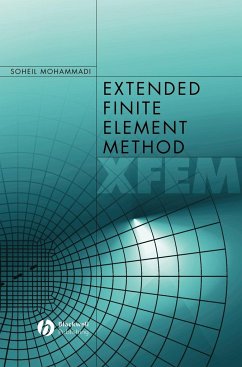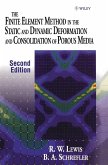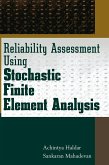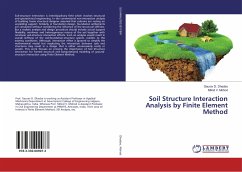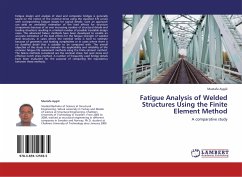- Gebundenes Buch
- Merkliste
- Auf die Merkliste
- Bewerten Bewerten
- Teilen
- Produkt teilen
- Produkterinnerung
- Produkterinnerung
This important textbook provides an introduction to the concepts of the newly developed extended finite element method (XFEM) for fracture analysis of structures, as well as for other related engineering applications. One of the main advantages of the method is that it avoids any need for remeshing or geometric crack modelling in numerical simulation, while generating discontinuous fields along a crack and around its tip. The second major advantage of the method is that by a small increase in number of degrees of freedom, far more accurate solutions can be obtained. The method has recently…mehr
Andere Kunden interessierten sich auch für
![The Finite Element Method in the Static and Dynamic Deformation and Consolidation of Porous Media The Finite Element Method in the Static and Dynamic Deformation and Consolidation of Porous Media]() Roland W. LewisThe Finite Element Method in the Static and Dynamic Deformation and Consolidation of Porous Media355,99 €
Roland W. LewisThe Finite Element Method in the Static and Dynamic Deformation and Consolidation of Porous Media355,99 €![Reliability Assessment Using Stochastic Finite Element Analysis Reliability Assessment Using Stochastic Finite Element Analysis]() Achintya HaldarReliability Assessment Using Stochastic Finite Element Analysis183,99 €
Achintya HaldarReliability Assessment Using Stochastic Finite Element Analysis183,99 €![Finite-Element Modelling of Unbounded Media Finite-Element Modelling of Unbounded Media]() John P WolfFinite-Element Modelling of Unbounded Media365,99 €
John P WolfFinite-Element Modelling of Unbounded Media365,99 €![Soil Structure Interaction Analysis by Finite Element Method Soil Structure Interaction Analysis by Finite Element Method]() Gaurav D. DhadseSoil Structure Interaction Analysis by Finite Element Method34,99 €
Gaurav D. DhadseSoil Structure Interaction Analysis by Finite Element Method34,99 €![The Finite Element Method for Research The Finite Element Method for Research]() abdolrasoul ranjbaranThe Finite Element Method for Research38,99 €
abdolrasoul ranjbaranThe Finite Element Method for Research38,99 €![A Numerical Study on an Earth Dam Safety By Using Finite Element Method A Numerical Study on an Earth Dam Safety By Using Finite Element Method]() Fathi Ghazi BajlanA Numerical Study on an Earth Dam Safety By Using Finite Element Method42,99 €
Fathi Ghazi BajlanA Numerical Study on an Earth Dam Safety By Using Finite Element Method42,99 €![Fatigue Analysis of Welded Structures Using the Finite Element Method Fatigue Analysis of Welded Structures Using the Finite Element Method]() Mustafa AygülFatigue Analysis of Welded Structures Using the Finite Element Method32,99 €
Mustafa AygülFatigue Analysis of Welded Structures Using the Finite Element Method32,99 €-
-
-
This important textbook provides an introduction to the concepts of the newly developed extended finite element method (XFEM) for fracture analysis of structures, as well as for other related engineering applications. One of the main advantages of the method is that it avoids any need for remeshing or geometric crack modelling in numerical simulation, while generating discontinuous fields along a crack and around its tip. The second major advantage of the method is that by a small increase in number of degrees of freedom, far more accurate solutions can be obtained. The method has recently been extended to nonlinear materials and other disciplines such as modelling contact and interface, simulation of inclusions and holes, moving and changing phase problems, and even to multiscale analyses. The book is self contained, with summaries of both classical and modern computational techniques. The main chapters include a comprehensive range of numerical examples describing various features of XFEM.
Hinweis: Dieser Artikel kann nur an eine deutsche Lieferadresse ausgeliefert werden.
Hinweis: Dieser Artikel kann nur an eine deutsche Lieferadresse ausgeliefert werden.
Produktdetails
- Produktdetails
- Verlag: Wiley
- Seitenzahl: 280
- Erscheinungstermin: 1. November 2007
- Englisch
- Abmessung: 250mm x 175mm x 20mm
- Gewicht: 669g
- ISBN-13: 9781405170604
- ISBN-10: 1405170603
- Artikelnr.: 23836715
- Herstellerkennzeichnung
- Libri GmbH
- Europaallee 1
- 36244 Bad Hersfeld
- gpsr@libri.de
- Verlag: Wiley
- Seitenzahl: 280
- Erscheinungstermin: 1. November 2007
- Englisch
- Abmessung: 250mm x 175mm x 20mm
- Gewicht: 669g
- ISBN-13: 9781405170604
- ISBN-10: 1405170603
- Artikelnr.: 23836715
- Herstellerkennzeichnung
- Libri GmbH
- Europaallee 1
- 36244 Bad Hersfeld
- gpsr@libri.de
Soheil Mohammadi is Associate Professor in the School of Civil Engineering at the University of Tehran. He has published in a wide range of journals, addressing theoretical aspects as well as practical applications, and has written one previous book: Discontinuum Mechanics using Finite and Discrete Elements 2003 WIT Press. He gained his PhD in Civil Engineering (Computational Mechanics) from the University of Wales Swansea.
Dedication.
Preface .
Nomenclature .
Chapter 1 Introduction.
1.1 ANALYSIS OF STRUCTURES.
1.2 ANALYSIS OF DISCONTINUITIES.
1.3 FRACTURE MECHANICS.
1.4 CRACK MODELLING.
1.4.1 Local and non-local models.
1.4.2 Smeared crack model.
1.4.3 Discrete inter-element crack.
1.4.4 Discrete cracked element.
1.4.5 Singular elements.
1.4.6 Enriched elements.
1.5 ALTERNATIVE TECHNIQUES.
1.6 A REVIEW OF XFEM APPLICATIONS.
1.6.1 General aspects of XFEM.
1.6.2 Localisation and fracture.
1.6.3 Composites.
1.6.4 Contact.
1.6.5 Dynamics.
1.6.6 Large deformation/shells.
1.6.7 Multiscale.
1.6.8 Multiphase/solidification.
1.7 SCOPE OF THE BOOK.
Chapter 2 Fracture Mechanics, a Review.
2.1 INTRODUCTION.
2.2 BASICS OF ELASTICITY.
2.2.1 Stress-strain relations.
2.2.2 Airy stress function.
2.2.3 Complex stress functions.
2.3 BASICS OF LEFM.
2.3.1 Fracture mechanics.
2.3.2 Circular hole.
2.3.3 Elliptical hole.
2.3.4 Westergaard analysis of a sharp crack.
2.4 STRESS INTENSITY FACTOR, K .
2.4.1 Definition of the stress intensity factor.
2.4.2 Examples of stress intensity factors for LEFM.
2.4.3 Griffith theories of strength and energy.
2.4.4 Brittle material.
2.4.5 Quasi-brittle material.
2.4.6 Crack stability.
2.4.7 Fixed grip versus fixed load.
2.4.8 Mixed mode crack propagation.
2.5 SOLUTION PROCEDURES FOR K AND G .
2.5.1 Displacement extrapolation/correlation method.
2.5.2 Mode I energy release rate.
2.5.3 Mode I stiffness derivative/virtual crack model.
2.5.4 Two virtual crack extensions for mixed mode cases.
2.5.5 Single virtual crack extension based on displacement decomposition.
2.5.6 Quarter point singular elements.
2.6 ELASTOPLASTIC FRACTURE MECHANICS (EPFM).
2.6.1 Plastic zone.
2.6.2 Crack tip opening displacements (CTOD).
2.6.3 J integral.
2.6.4 Plastic crack tip fields.
2.6.5 Generalisation of J .
2.7 NUMERICAL METHODS BASED ON THE J INTEGRAL.
2.7.1 Nodal solution.
2.7.2 General finite element solution.
2.7.3 Equivalent domain integral (EDI) method.
2.7.4 Interaction integral method.
Chapter 3 Extended Finite Element Method for Isotropic Problems.
3.1 INTRODUCTION.
3.2 A REVIEW OF XFEM DEVELOPMENT.
3.3 BASICS OF FEM.
3.3.1 Isoparametric finite elements, a short review.
3.3.2 Finite element solutions for fracture mechanics.
3.4 PARTITION OF UNITY.
3.5 ENRICHMENT.
3.5.1 Intrinsic enrichment.
3.5.2 Extrinsic enrichment.
3.5.3 Partition of unity finite element method.
3.5.4 Generalised finite element method.
3.5.5 Extended finite element method.
3.5.6 Hp-clouds enrichment.
3.5.7 Generalisation of the PU enrichment.
3.5.8 Transition from standard to enriched approximation.
3.6 ISOTROPIC XFEM.
3.6.1 Basic XFEM approximation.
3.6.2 Signed distance function.
3.6.3 Modelling strong discontinuous fields.
3.6.4 Modelling weak discontinuous fields.
3.6.5 Plastic enrichment.
3.6.6 Selection of nodes for discontinuity enrichment.
3.6.7 Modelling the crack.
3.7 DISCRETIZATION AND INTEGRATION.
3.7.1 Governing equation.
3.7.2 XFEM discretization.
3.7.3 Element partitioning and numerical integration.
3.7.4 Crack intersection.
3.8 TRACKING MOVING BOUNDARIES.
3.8.1 Level set method.
3.8.2 Fast marching method.
3.8.3 Ordered upwind method.
3.9 NUMERICAL SIMULATIONS.
3.9.1 A tensile plate with a central crack.
3.9.2 Double edge cracks.
3.9.3 Double internal collinear cracks.
3.9.4 A central crack in an infinite plate.
3.9.5 An edge crack in a finite plate.
Chapter 4 XFEM for Orthotropic Problems.
4.1 INTRODUCTION.
4.2 ANISOTROPIC ELASTICITY.
4.2.1 Elasticity solution.
4.2.2 Anisotropic stress functions.
4.2.3 Orthotropic mixed mode problems.
4.2.4 Energy release rate and stress intensity factor for anisotropic.
materials.
4.2.5 Anisotropic singular elements.
4.3 ANALYTICAL SOLUTIONS FOR NEAR CRACK TIP.
4.3.1 Near crack tip displacement field (class I).
4.3.2 Near crack tip displacement field (class II).
4.3.3 Unified near crack tip displacement field (both classes).
4.4 ANISOTROPIC XFEM.
4.4.1 Governing equation.
4.4.2 XFEM discretization.
4.4.3 SIF calculations.
4.5 NUMERICAL SIMULATIONS.
4.5.1 Plate with a crack parallel to material axis of orthotropy.
4.5.2 Edge crack with several orientations of the axes of orthotropy.
4.5.3 Single edge notched tensile specimen with crack inclination.
4.5.4 Central slanted crack.
4.5.5 An inclined centre crack in a disk subjected to point loads.
4.5.6 A crack between orthotropic and isotropic materials subjected to.
tensile tractions.
Chapter 5 XFEM for Cohesive Cracks.
5.1 INTRODUCTION.
5.2 COHESIVE CRACKS.
5.2.1 Cohesive crack models.
5.2.2 Numerical models for cohesive cracks.
5.2.3 Crack propagation criteria.
5.2.4 Snap-back behaviour.
5.2.5 Griffith criterion for cohesive crack.
5.2.6 Cohesive crack model.
5.3 XFEM FOR COHESIVE CRACKS.
5.3.1 Enrichment functions.
5.3.2 Governing equations.
5.3.3 XFEM discretization.
5.4 NUMERICAL SIMULATIONS.
5.4.1 Mixed mode bending beam.
5.4.2 Four point bending beam.
5.4.3 Double cantilever beam.
Chapter 6 New Frontiers.
6.1 INTRODUCTION.
6.2 INTERFACE CRACKS.
6.2.1 Elasticity solution for isotropic bimaterial interface.
6.2.2 Stability of interface cracks.
6.2.3 XFEM approximation for interface cracks.
6.3 CONTACT.
6.3.1 Numerical models for a contact problem.
6.3.2 XFEM modelling of a contact problem.
6.4 DYNAMIC FRACTURE.
6.4.1 Dynamic crack propagation by XFEM.
6.4.2 Dynamic LEFM.
6.4.3 Dynamic orthotropic LEFM.
6.4.4 Basic formulation of dynamic XFEM.
6.4.5 XFEM discretization.
6.4.6 Time integration.
6.4.7 Time finite element method.
6.4.8 Time extended finite element method.
6.5 MULTISCALE XFEM.
6.5.1 Basic formulation.
6.5.2 The zoom technique.
6.5.3 Homogenisation based techniques.
6.5.4 XFEM discretization.
6.6 MULTIPHASE XFEM.
6.6.1 Basic formulation.
6.6.2 XFEM approximation.
6.6.3 Two-phase fluid flow.
6.6.4 XFEM approximation.
Chapter 7 XFEM Flow.
7.1 INTRODUCTION.
7.2 AVAILABLE OPEN-SOURCE XFEM.
7.3. FINITE ELEMENT ANALYSIS.
7.3.1 Defining the model.
7.3.2 Creating the finite element mesh.
7.3.3 Linear elastic analysis.
7.3.4 Large deformation.
7.3.5 Nonlinear (elastoplastic) analysis.
7.3.6 Material constitutive matrix.
7.4 XFEM.
7.4.1 Front tracking.
7.4.2 Enrichment detection.
7.4.3 Enrichment functions.
7.4.4 Ramp (transition) functions.
7.4.5 Evaluation of the B matrix.
7.5 NUMERICAL INTEGRATION.
7.5.1 Sub-quads.
7.5.2 Sub-triangles.
7.6 SOLVER.
7.6.1 XFEM degrees of freedom.
7.6.2 Time integration.
7.6.3 Simultaneous equations solver.
7.6.4 Crack length control.
7.7 POST-PROCESSING.
7.7.1 Stress intensity factor.
7.7.2 Crack growth.
7.7.3 Other applications.
7.8 CONFIGURATION UPDATE.
References .
Index
Preface .
Nomenclature .
Chapter 1 Introduction.
1.1 ANALYSIS OF STRUCTURES.
1.2 ANALYSIS OF DISCONTINUITIES.
1.3 FRACTURE MECHANICS.
1.4 CRACK MODELLING.
1.4.1 Local and non-local models.
1.4.2 Smeared crack model.
1.4.3 Discrete inter-element crack.
1.4.4 Discrete cracked element.
1.4.5 Singular elements.
1.4.6 Enriched elements.
1.5 ALTERNATIVE TECHNIQUES.
1.6 A REVIEW OF XFEM APPLICATIONS.
1.6.1 General aspects of XFEM.
1.6.2 Localisation and fracture.
1.6.3 Composites.
1.6.4 Contact.
1.6.5 Dynamics.
1.6.6 Large deformation/shells.
1.6.7 Multiscale.
1.6.8 Multiphase/solidification.
1.7 SCOPE OF THE BOOK.
Chapter 2 Fracture Mechanics, a Review.
2.1 INTRODUCTION.
2.2 BASICS OF ELASTICITY.
2.2.1 Stress-strain relations.
2.2.2 Airy stress function.
2.2.3 Complex stress functions.
2.3 BASICS OF LEFM.
2.3.1 Fracture mechanics.
2.3.2 Circular hole.
2.3.3 Elliptical hole.
2.3.4 Westergaard analysis of a sharp crack.
2.4 STRESS INTENSITY FACTOR, K .
2.4.1 Definition of the stress intensity factor.
2.4.2 Examples of stress intensity factors for LEFM.
2.4.3 Griffith theories of strength and energy.
2.4.4 Brittle material.
2.4.5 Quasi-brittle material.
2.4.6 Crack stability.
2.4.7 Fixed grip versus fixed load.
2.4.8 Mixed mode crack propagation.
2.5 SOLUTION PROCEDURES FOR K AND G .
2.5.1 Displacement extrapolation/correlation method.
2.5.2 Mode I energy release rate.
2.5.3 Mode I stiffness derivative/virtual crack model.
2.5.4 Two virtual crack extensions for mixed mode cases.
2.5.5 Single virtual crack extension based on displacement decomposition.
2.5.6 Quarter point singular elements.
2.6 ELASTOPLASTIC FRACTURE MECHANICS (EPFM).
2.6.1 Plastic zone.
2.6.2 Crack tip opening displacements (CTOD).
2.6.3 J integral.
2.6.4 Plastic crack tip fields.
2.6.5 Generalisation of J .
2.7 NUMERICAL METHODS BASED ON THE J INTEGRAL.
2.7.1 Nodal solution.
2.7.2 General finite element solution.
2.7.3 Equivalent domain integral (EDI) method.
2.7.4 Interaction integral method.
Chapter 3 Extended Finite Element Method for Isotropic Problems.
3.1 INTRODUCTION.
3.2 A REVIEW OF XFEM DEVELOPMENT.
3.3 BASICS OF FEM.
3.3.1 Isoparametric finite elements, a short review.
3.3.2 Finite element solutions for fracture mechanics.
3.4 PARTITION OF UNITY.
3.5 ENRICHMENT.
3.5.1 Intrinsic enrichment.
3.5.2 Extrinsic enrichment.
3.5.3 Partition of unity finite element method.
3.5.4 Generalised finite element method.
3.5.5 Extended finite element method.
3.5.6 Hp-clouds enrichment.
3.5.7 Generalisation of the PU enrichment.
3.5.8 Transition from standard to enriched approximation.
3.6 ISOTROPIC XFEM.
3.6.1 Basic XFEM approximation.
3.6.2 Signed distance function.
3.6.3 Modelling strong discontinuous fields.
3.6.4 Modelling weak discontinuous fields.
3.6.5 Plastic enrichment.
3.6.6 Selection of nodes for discontinuity enrichment.
3.6.7 Modelling the crack.
3.7 DISCRETIZATION AND INTEGRATION.
3.7.1 Governing equation.
3.7.2 XFEM discretization.
3.7.3 Element partitioning and numerical integration.
3.7.4 Crack intersection.
3.8 TRACKING MOVING BOUNDARIES.
3.8.1 Level set method.
3.8.2 Fast marching method.
3.8.3 Ordered upwind method.
3.9 NUMERICAL SIMULATIONS.
3.9.1 A tensile plate with a central crack.
3.9.2 Double edge cracks.
3.9.3 Double internal collinear cracks.
3.9.4 A central crack in an infinite plate.
3.9.5 An edge crack in a finite plate.
Chapter 4 XFEM for Orthotropic Problems.
4.1 INTRODUCTION.
4.2 ANISOTROPIC ELASTICITY.
4.2.1 Elasticity solution.
4.2.2 Anisotropic stress functions.
4.2.3 Orthotropic mixed mode problems.
4.2.4 Energy release rate and stress intensity factor for anisotropic.
materials.
4.2.5 Anisotropic singular elements.
4.3 ANALYTICAL SOLUTIONS FOR NEAR CRACK TIP.
4.3.1 Near crack tip displacement field (class I).
4.3.2 Near crack tip displacement field (class II).
4.3.3 Unified near crack tip displacement field (both classes).
4.4 ANISOTROPIC XFEM.
4.4.1 Governing equation.
4.4.2 XFEM discretization.
4.4.3 SIF calculations.
4.5 NUMERICAL SIMULATIONS.
4.5.1 Plate with a crack parallel to material axis of orthotropy.
4.5.2 Edge crack with several orientations of the axes of orthotropy.
4.5.3 Single edge notched tensile specimen with crack inclination.
4.5.4 Central slanted crack.
4.5.5 An inclined centre crack in a disk subjected to point loads.
4.5.6 A crack between orthotropic and isotropic materials subjected to.
tensile tractions.
Chapter 5 XFEM for Cohesive Cracks.
5.1 INTRODUCTION.
5.2 COHESIVE CRACKS.
5.2.1 Cohesive crack models.
5.2.2 Numerical models for cohesive cracks.
5.2.3 Crack propagation criteria.
5.2.4 Snap-back behaviour.
5.2.5 Griffith criterion for cohesive crack.
5.2.6 Cohesive crack model.
5.3 XFEM FOR COHESIVE CRACKS.
5.3.1 Enrichment functions.
5.3.2 Governing equations.
5.3.3 XFEM discretization.
5.4 NUMERICAL SIMULATIONS.
5.4.1 Mixed mode bending beam.
5.4.2 Four point bending beam.
5.4.3 Double cantilever beam.
Chapter 6 New Frontiers.
6.1 INTRODUCTION.
6.2 INTERFACE CRACKS.
6.2.1 Elasticity solution for isotropic bimaterial interface.
6.2.2 Stability of interface cracks.
6.2.3 XFEM approximation for interface cracks.
6.3 CONTACT.
6.3.1 Numerical models for a contact problem.
6.3.2 XFEM modelling of a contact problem.
6.4 DYNAMIC FRACTURE.
6.4.1 Dynamic crack propagation by XFEM.
6.4.2 Dynamic LEFM.
6.4.3 Dynamic orthotropic LEFM.
6.4.4 Basic formulation of dynamic XFEM.
6.4.5 XFEM discretization.
6.4.6 Time integration.
6.4.7 Time finite element method.
6.4.8 Time extended finite element method.
6.5 MULTISCALE XFEM.
6.5.1 Basic formulation.
6.5.2 The zoom technique.
6.5.3 Homogenisation based techniques.
6.5.4 XFEM discretization.
6.6 MULTIPHASE XFEM.
6.6.1 Basic formulation.
6.6.2 XFEM approximation.
6.6.3 Two-phase fluid flow.
6.6.4 XFEM approximation.
Chapter 7 XFEM Flow.
7.1 INTRODUCTION.
7.2 AVAILABLE OPEN-SOURCE XFEM.
7.3. FINITE ELEMENT ANALYSIS.
7.3.1 Defining the model.
7.3.2 Creating the finite element mesh.
7.3.3 Linear elastic analysis.
7.3.4 Large deformation.
7.3.5 Nonlinear (elastoplastic) analysis.
7.3.6 Material constitutive matrix.
7.4 XFEM.
7.4.1 Front tracking.
7.4.2 Enrichment detection.
7.4.3 Enrichment functions.
7.4.4 Ramp (transition) functions.
7.4.5 Evaluation of the B matrix.
7.5 NUMERICAL INTEGRATION.
7.5.1 Sub-quads.
7.5.2 Sub-triangles.
7.6 SOLVER.
7.6.1 XFEM degrees of freedom.
7.6.2 Time integration.
7.6.3 Simultaneous equations solver.
7.6.4 Crack length control.
7.7 POST-PROCESSING.
7.7.1 Stress intensity factor.
7.7.2 Crack growth.
7.7.3 Other applications.
7.8 CONFIGURATION UPDATE.
References .
Index
Dedication.
Preface .
Nomenclature .
Chapter 1 Introduction.
1.1 ANALYSIS OF STRUCTURES.
1.2 ANALYSIS OF DISCONTINUITIES.
1.3 FRACTURE MECHANICS.
1.4 CRACK MODELLING.
1.4.1 Local and non-local models.
1.4.2 Smeared crack model.
1.4.3 Discrete inter-element crack.
1.4.4 Discrete cracked element.
1.4.5 Singular elements.
1.4.6 Enriched elements.
1.5 ALTERNATIVE TECHNIQUES.
1.6 A REVIEW OF XFEM APPLICATIONS.
1.6.1 General aspects of XFEM.
1.6.2 Localisation and fracture.
1.6.3 Composites.
1.6.4 Contact.
1.6.5 Dynamics.
1.6.6 Large deformation/shells.
1.6.7 Multiscale.
1.6.8 Multiphase/solidification.
1.7 SCOPE OF THE BOOK.
Chapter 2 Fracture Mechanics, a Review.
2.1 INTRODUCTION.
2.2 BASICS OF ELASTICITY.
2.2.1 Stress-strain relations.
2.2.2 Airy stress function.
2.2.3 Complex stress functions.
2.3 BASICS OF LEFM.
2.3.1 Fracture mechanics.
2.3.2 Circular hole.
2.3.3 Elliptical hole.
2.3.4 Westergaard analysis of a sharp crack.
2.4 STRESS INTENSITY FACTOR, K .
2.4.1 Definition of the stress intensity factor.
2.4.2 Examples of stress intensity factors for LEFM.
2.4.3 Griffith theories of strength and energy.
2.4.4 Brittle material.
2.4.5 Quasi-brittle material.
2.4.6 Crack stability.
2.4.7 Fixed grip versus fixed load.
2.4.8 Mixed mode crack propagation.
2.5 SOLUTION PROCEDURES FOR K AND G .
2.5.1 Displacement extrapolation/correlation method.
2.5.2 Mode I energy release rate.
2.5.3 Mode I stiffness derivative/virtual crack model.
2.5.4 Two virtual crack extensions for mixed mode cases.
2.5.5 Single virtual crack extension based on displacement decomposition.
2.5.6 Quarter point singular elements.
2.6 ELASTOPLASTIC FRACTURE MECHANICS (EPFM).
2.6.1 Plastic zone.
2.6.2 Crack tip opening displacements (CTOD).
2.6.3 J integral.
2.6.4 Plastic crack tip fields.
2.6.5 Generalisation of J .
2.7 NUMERICAL METHODS BASED ON THE J INTEGRAL.
2.7.1 Nodal solution.
2.7.2 General finite element solution.
2.7.3 Equivalent domain integral (EDI) method.
2.7.4 Interaction integral method.
Chapter 3 Extended Finite Element Method for Isotropic Problems.
3.1 INTRODUCTION.
3.2 A REVIEW OF XFEM DEVELOPMENT.
3.3 BASICS OF FEM.
3.3.1 Isoparametric finite elements, a short review.
3.3.2 Finite element solutions for fracture mechanics.
3.4 PARTITION OF UNITY.
3.5 ENRICHMENT.
3.5.1 Intrinsic enrichment.
3.5.2 Extrinsic enrichment.
3.5.3 Partition of unity finite element method.
3.5.4 Generalised finite element method.
3.5.5 Extended finite element method.
3.5.6 Hp-clouds enrichment.
3.5.7 Generalisation of the PU enrichment.
3.5.8 Transition from standard to enriched approximation.
3.6 ISOTROPIC XFEM.
3.6.1 Basic XFEM approximation.
3.6.2 Signed distance function.
3.6.3 Modelling strong discontinuous fields.
3.6.4 Modelling weak discontinuous fields.
3.6.5 Plastic enrichment.
3.6.6 Selection of nodes for discontinuity enrichment.
3.6.7 Modelling the crack.
3.7 DISCRETIZATION AND INTEGRATION.
3.7.1 Governing equation.
3.7.2 XFEM discretization.
3.7.3 Element partitioning and numerical integration.
3.7.4 Crack intersection.
3.8 TRACKING MOVING BOUNDARIES.
3.8.1 Level set method.
3.8.2 Fast marching method.
3.8.3 Ordered upwind method.
3.9 NUMERICAL SIMULATIONS.
3.9.1 A tensile plate with a central crack.
3.9.2 Double edge cracks.
3.9.3 Double internal collinear cracks.
3.9.4 A central crack in an infinite plate.
3.9.5 An edge crack in a finite plate.
Chapter 4 XFEM for Orthotropic Problems.
4.1 INTRODUCTION.
4.2 ANISOTROPIC ELASTICITY.
4.2.1 Elasticity solution.
4.2.2 Anisotropic stress functions.
4.2.3 Orthotropic mixed mode problems.
4.2.4 Energy release rate and stress intensity factor for anisotropic.
materials.
4.2.5 Anisotropic singular elements.
4.3 ANALYTICAL SOLUTIONS FOR NEAR CRACK TIP.
4.3.1 Near crack tip displacement field (class I).
4.3.2 Near crack tip displacement field (class II).
4.3.3 Unified near crack tip displacement field (both classes).
4.4 ANISOTROPIC XFEM.
4.4.1 Governing equation.
4.4.2 XFEM discretization.
4.4.3 SIF calculations.
4.5 NUMERICAL SIMULATIONS.
4.5.1 Plate with a crack parallel to material axis of orthotropy.
4.5.2 Edge crack with several orientations of the axes of orthotropy.
4.5.3 Single edge notched tensile specimen with crack inclination.
4.5.4 Central slanted crack.
4.5.5 An inclined centre crack in a disk subjected to point loads.
4.5.6 A crack between orthotropic and isotropic materials subjected to.
tensile tractions.
Chapter 5 XFEM for Cohesive Cracks.
5.1 INTRODUCTION.
5.2 COHESIVE CRACKS.
5.2.1 Cohesive crack models.
5.2.2 Numerical models for cohesive cracks.
5.2.3 Crack propagation criteria.
5.2.4 Snap-back behaviour.
5.2.5 Griffith criterion for cohesive crack.
5.2.6 Cohesive crack model.
5.3 XFEM FOR COHESIVE CRACKS.
5.3.1 Enrichment functions.
5.3.2 Governing equations.
5.3.3 XFEM discretization.
5.4 NUMERICAL SIMULATIONS.
5.4.1 Mixed mode bending beam.
5.4.2 Four point bending beam.
5.4.3 Double cantilever beam.
Chapter 6 New Frontiers.
6.1 INTRODUCTION.
6.2 INTERFACE CRACKS.
6.2.1 Elasticity solution for isotropic bimaterial interface.
6.2.2 Stability of interface cracks.
6.2.3 XFEM approximation for interface cracks.
6.3 CONTACT.
6.3.1 Numerical models for a contact problem.
6.3.2 XFEM modelling of a contact problem.
6.4 DYNAMIC FRACTURE.
6.4.1 Dynamic crack propagation by XFEM.
6.4.2 Dynamic LEFM.
6.4.3 Dynamic orthotropic LEFM.
6.4.4 Basic formulation of dynamic XFEM.
6.4.5 XFEM discretization.
6.4.6 Time integration.
6.4.7 Time finite element method.
6.4.8 Time extended finite element method.
6.5 MULTISCALE XFEM.
6.5.1 Basic formulation.
6.5.2 The zoom technique.
6.5.3 Homogenisation based techniques.
6.5.4 XFEM discretization.
6.6 MULTIPHASE XFEM.
6.6.1 Basic formulation.
6.6.2 XFEM approximation.
6.6.3 Two-phase fluid flow.
6.6.4 XFEM approximation.
Chapter 7 XFEM Flow.
7.1 INTRODUCTION.
7.2 AVAILABLE OPEN-SOURCE XFEM.
7.3. FINITE ELEMENT ANALYSIS.
7.3.1 Defining the model.
7.3.2 Creating the finite element mesh.
7.3.3 Linear elastic analysis.
7.3.4 Large deformation.
7.3.5 Nonlinear (elastoplastic) analysis.
7.3.6 Material constitutive matrix.
7.4 XFEM.
7.4.1 Front tracking.
7.4.2 Enrichment detection.
7.4.3 Enrichment functions.
7.4.4 Ramp (transition) functions.
7.4.5 Evaluation of the B matrix.
7.5 NUMERICAL INTEGRATION.
7.5.1 Sub-quads.
7.5.2 Sub-triangles.
7.6 SOLVER.
7.6.1 XFEM degrees of freedom.
7.6.2 Time integration.
7.6.3 Simultaneous equations solver.
7.6.4 Crack length control.
7.7 POST-PROCESSING.
7.7.1 Stress intensity factor.
7.7.2 Crack growth.
7.7.3 Other applications.
7.8 CONFIGURATION UPDATE.
References .
Index
Preface .
Nomenclature .
Chapter 1 Introduction.
1.1 ANALYSIS OF STRUCTURES.
1.2 ANALYSIS OF DISCONTINUITIES.
1.3 FRACTURE MECHANICS.
1.4 CRACK MODELLING.
1.4.1 Local and non-local models.
1.4.2 Smeared crack model.
1.4.3 Discrete inter-element crack.
1.4.4 Discrete cracked element.
1.4.5 Singular elements.
1.4.6 Enriched elements.
1.5 ALTERNATIVE TECHNIQUES.
1.6 A REVIEW OF XFEM APPLICATIONS.
1.6.1 General aspects of XFEM.
1.6.2 Localisation and fracture.
1.6.3 Composites.
1.6.4 Contact.
1.6.5 Dynamics.
1.6.6 Large deformation/shells.
1.6.7 Multiscale.
1.6.8 Multiphase/solidification.
1.7 SCOPE OF THE BOOK.
Chapter 2 Fracture Mechanics, a Review.
2.1 INTRODUCTION.
2.2 BASICS OF ELASTICITY.
2.2.1 Stress-strain relations.
2.2.2 Airy stress function.
2.2.3 Complex stress functions.
2.3 BASICS OF LEFM.
2.3.1 Fracture mechanics.
2.3.2 Circular hole.
2.3.3 Elliptical hole.
2.3.4 Westergaard analysis of a sharp crack.
2.4 STRESS INTENSITY FACTOR, K .
2.4.1 Definition of the stress intensity factor.
2.4.2 Examples of stress intensity factors for LEFM.
2.4.3 Griffith theories of strength and energy.
2.4.4 Brittle material.
2.4.5 Quasi-brittle material.
2.4.6 Crack stability.
2.4.7 Fixed grip versus fixed load.
2.4.8 Mixed mode crack propagation.
2.5 SOLUTION PROCEDURES FOR K AND G .
2.5.1 Displacement extrapolation/correlation method.
2.5.2 Mode I energy release rate.
2.5.3 Mode I stiffness derivative/virtual crack model.
2.5.4 Two virtual crack extensions for mixed mode cases.
2.5.5 Single virtual crack extension based on displacement decomposition.
2.5.6 Quarter point singular elements.
2.6 ELASTOPLASTIC FRACTURE MECHANICS (EPFM).
2.6.1 Plastic zone.
2.6.2 Crack tip opening displacements (CTOD).
2.6.3 J integral.
2.6.4 Plastic crack tip fields.
2.6.5 Generalisation of J .
2.7 NUMERICAL METHODS BASED ON THE J INTEGRAL.
2.7.1 Nodal solution.
2.7.2 General finite element solution.
2.7.3 Equivalent domain integral (EDI) method.
2.7.4 Interaction integral method.
Chapter 3 Extended Finite Element Method for Isotropic Problems.
3.1 INTRODUCTION.
3.2 A REVIEW OF XFEM DEVELOPMENT.
3.3 BASICS OF FEM.
3.3.1 Isoparametric finite elements, a short review.
3.3.2 Finite element solutions for fracture mechanics.
3.4 PARTITION OF UNITY.
3.5 ENRICHMENT.
3.5.1 Intrinsic enrichment.
3.5.2 Extrinsic enrichment.
3.5.3 Partition of unity finite element method.
3.5.4 Generalised finite element method.
3.5.5 Extended finite element method.
3.5.6 Hp-clouds enrichment.
3.5.7 Generalisation of the PU enrichment.
3.5.8 Transition from standard to enriched approximation.
3.6 ISOTROPIC XFEM.
3.6.1 Basic XFEM approximation.
3.6.2 Signed distance function.
3.6.3 Modelling strong discontinuous fields.
3.6.4 Modelling weak discontinuous fields.
3.6.5 Plastic enrichment.
3.6.6 Selection of nodes for discontinuity enrichment.
3.6.7 Modelling the crack.
3.7 DISCRETIZATION AND INTEGRATION.
3.7.1 Governing equation.
3.7.2 XFEM discretization.
3.7.3 Element partitioning and numerical integration.
3.7.4 Crack intersection.
3.8 TRACKING MOVING BOUNDARIES.
3.8.1 Level set method.
3.8.2 Fast marching method.
3.8.3 Ordered upwind method.
3.9 NUMERICAL SIMULATIONS.
3.9.1 A tensile plate with a central crack.
3.9.2 Double edge cracks.
3.9.3 Double internal collinear cracks.
3.9.4 A central crack in an infinite plate.
3.9.5 An edge crack in a finite plate.
Chapter 4 XFEM for Orthotropic Problems.
4.1 INTRODUCTION.
4.2 ANISOTROPIC ELASTICITY.
4.2.1 Elasticity solution.
4.2.2 Anisotropic stress functions.
4.2.3 Orthotropic mixed mode problems.
4.2.4 Energy release rate and stress intensity factor for anisotropic.
materials.
4.2.5 Anisotropic singular elements.
4.3 ANALYTICAL SOLUTIONS FOR NEAR CRACK TIP.
4.3.1 Near crack tip displacement field (class I).
4.3.2 Near crack tip displacement field (class II).
4.3.3 Unified near crack tip displacement field (both classes).
4.4 ANISOTROPIC XFEM.
4.4.1 Governing equation.
4.4.2 XFEM discretization.
4.4.3 SIF calculations.
4.5 NUMERICAL SIMULATIONS.
4.5.1 Plate with a crack parallel to material axis of orthotropy.
4.5.2 Edge crack with several orientations of the axes of orthotropy.
4.5.3 Single edge notched tensile specimen with crack inclination.
4.5.4 Central slanted crack.
4.5.5 An inclined centre crack in a disk subjected to point loads.
4.5.6 A crack between orthotropic and isotropic materials subjected to.
tensile tractions.
Chapter 5 XFEM for Cohesive Cracks.
5.1 INTRODUCTION.
5.2 COHESIVE CRACKS.
5.2.1 Cohesive crack models.
5.2.2 Numerical models for cohesive cracks.
5.2.3 Crack propagation criteria.
5.2.4 Snap-back behaviour.
5.2.5 Griffith criterion for cohesive crack.
5.2.6 Cohesive crack model.
5.3 XFEM FOR COHESIVE CRACKS.
5.3.1 Enrichment functions.
5.3.2 Governing equations.
5.3.3 XFEM discretization.
5.4 NUMERICAL SIMULATIONS.
5.4.1 Mixed mode bending beam.
5.4.2 Four point bending beam.
5.4.3 Double cantilever beam.
Chapter 6 New Frontiers.
6.1 INTRODUCTION.
6.2 INTERFACE CRACKS.
6.2.1 Elasticity solution for isotropic bimaterial interface.
6.2.2 Stability of interface cracks.
6.2.3 XFEM approximation for interface cracks.
6.3 CONTACT.
6.3.1 Numerical models for a contact problem.
6.3.2 XFEM modelling of a contact problem.
6.4 DYNAMIC FRACTURE.
6.4.1 Dynamic crack propagation by XFEM.
6.4.2 Dynamic LEFM.
6.4.3 Dynamic orthotropic LEFM.
6.4.4 Basic formulation of dynamic XFEM.
6.4.5 XFEM discretization.
6.4.6 Time integration.
6.4.7 Time finite element method.
6.4.8 Time extended finite element method.
6.5 MULTISCALE XFEM.
6.5.1 Basic formulation.
6.5.2 The zoom technique.
6.5.3 Homogenisation based techniques.
6.5.4 XFEM discretization.
6.6 MULTIPHASE XFEM.
6.6.1 Basic formulation.
6.6.2 XFEM approximation.
6.6.3 Two-phase fluid flow.
6.6.4 XFEM approximation.
Chapter 7 XFEM Flow.
7.1 INTRODUCTION.
7.2 AVAILABLE OPEN-SOURCE XFEM.
7.3. FINITE ELEMENT ANALYSIS.
7.3.1 Defining the model.
7.3.2 Creating the finite element mesh.
7.3.3 Linear elastic analysis.
7.3.4 Large deformation.
7.3.5 Nonlinear (elastoplastic) analysis.
7.3.6 Material constitutive matrix.
7.4 XFEM.
7.4.1 Front tracking.
7.4.2 Enrichment detection.
7.4.3 Enrichment functions.
7.4.4 Ramp (transition) functions.
7.4.5 Evaluation of the B matrix.
7.5 NUMERICAL INTEGRATION.
7.5.1 Sub-quads.
7.5.2 Sub-triangles.
7.6 SOLVER.
7.6.1 XFEM degrees of freedom.
7.6.2 Time integration.
7.6.3 Simultaneous equations solver.
7.6.4 Crack length control.
7.7 POST-PROCESSING.
7.7.1 Stress intensity factor.
7.7.2 Crack growth.
7.7.3 Other applications.
7.8 CONFIGURATION UPDATE.
References .
Index

